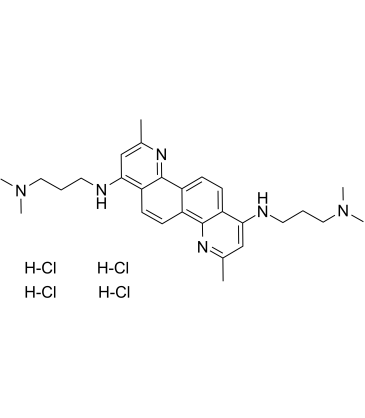| Description |
FGI-106 tetrahydrochloride is a potent and broad-spectrum inhibitor with inhibitory activity against multiple viruses. FGI-106 tetrahydrochloride is active against Ebola, Rift Valley and Dengue Fever viruses with EC50s of 100 nM, 800 nM and 400-900 nM, respectively. FGI-106 tetrahydrochloride also inhibits non-hemorrhagic fever viruses HCV and HIV-1 with EC50s of 200 nM and 150 nM, respectively[1].
|
| Related Catalog |
|
| Target |
EC50: 100 nM (Ebola virus), 800 nM (Rift Valley virus), 400-900 nM (Dengue Fever virus), 200 nM (HCV) and 150 nM (HIV-1)[1]
|
| In Vitro |
Treatment with 2 μM FGI-106 mediated a 4 log reduction in infectious viral titers relative to matched controls, with an EC90 for inhibition of viral killing of host cells (Vero E6 cells) estimated to be 0.6 μM[1]. In cell-based assays, treatment with FGI-106 inhibits viral replication by divergent virus families, including positive and negative-strand RNA viruses[1].
|
| In Vivo |
FGI-106 (0.1-5 mg/kg; intraperitoneal injection; treatments on days 2 and 5; C57BL/6 or BALB/c mice) treatment decreases mortality from Zaire EBOV in a dose-dependent manner[1]. Animal Model: Male or female C57BL/6 or BALB/c mice (6-10 weeks of age) injected with EBOV (Ebola virus)[1] Dosage: 0.1 mg/kg, 0.5 mg/kg, 1 mg/kg, 2 mg/kg, 5 mg/kg Administration: Intraperitoneal injection; treatments on days 2 and 5 Result: Decreased mortality from Zaire EBOV in a dose-dependent manner.
|
| References |
[1]. Aman MJ, et al. Development of a broad-spectrum antiviral with activity against Ebola virus. Antiviral Res. 2009 Sep;83(3):245-51.
|
